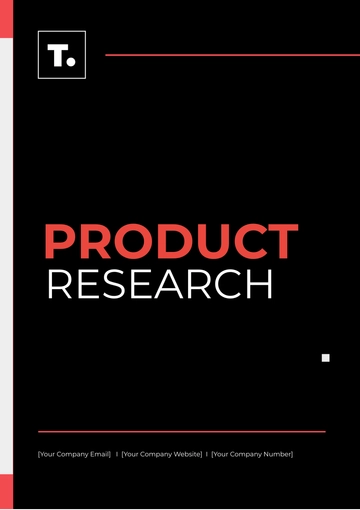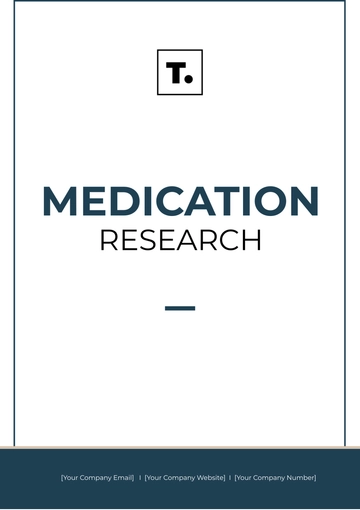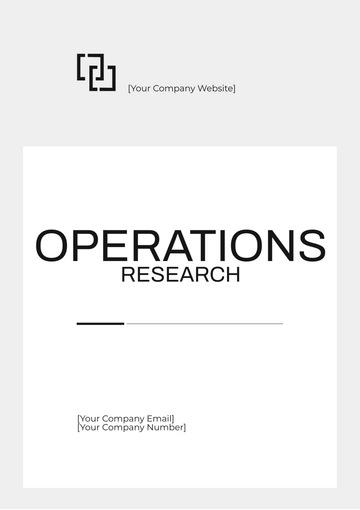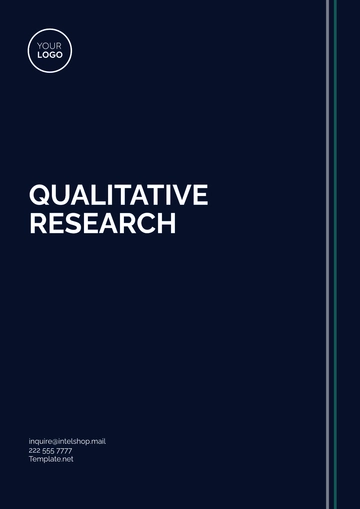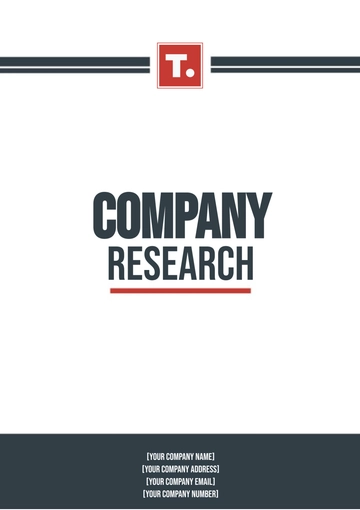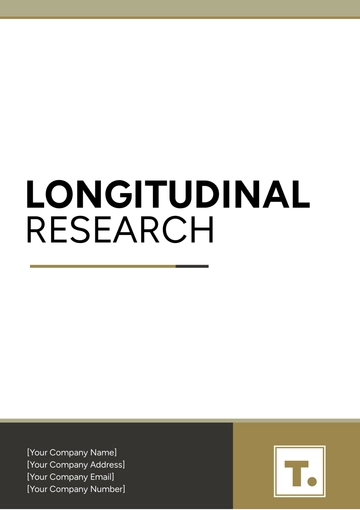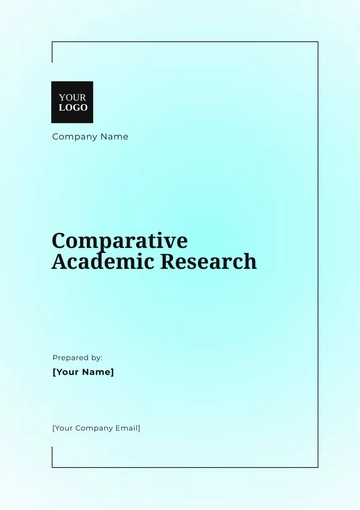Free Finance Mergers & Acquisitions Research
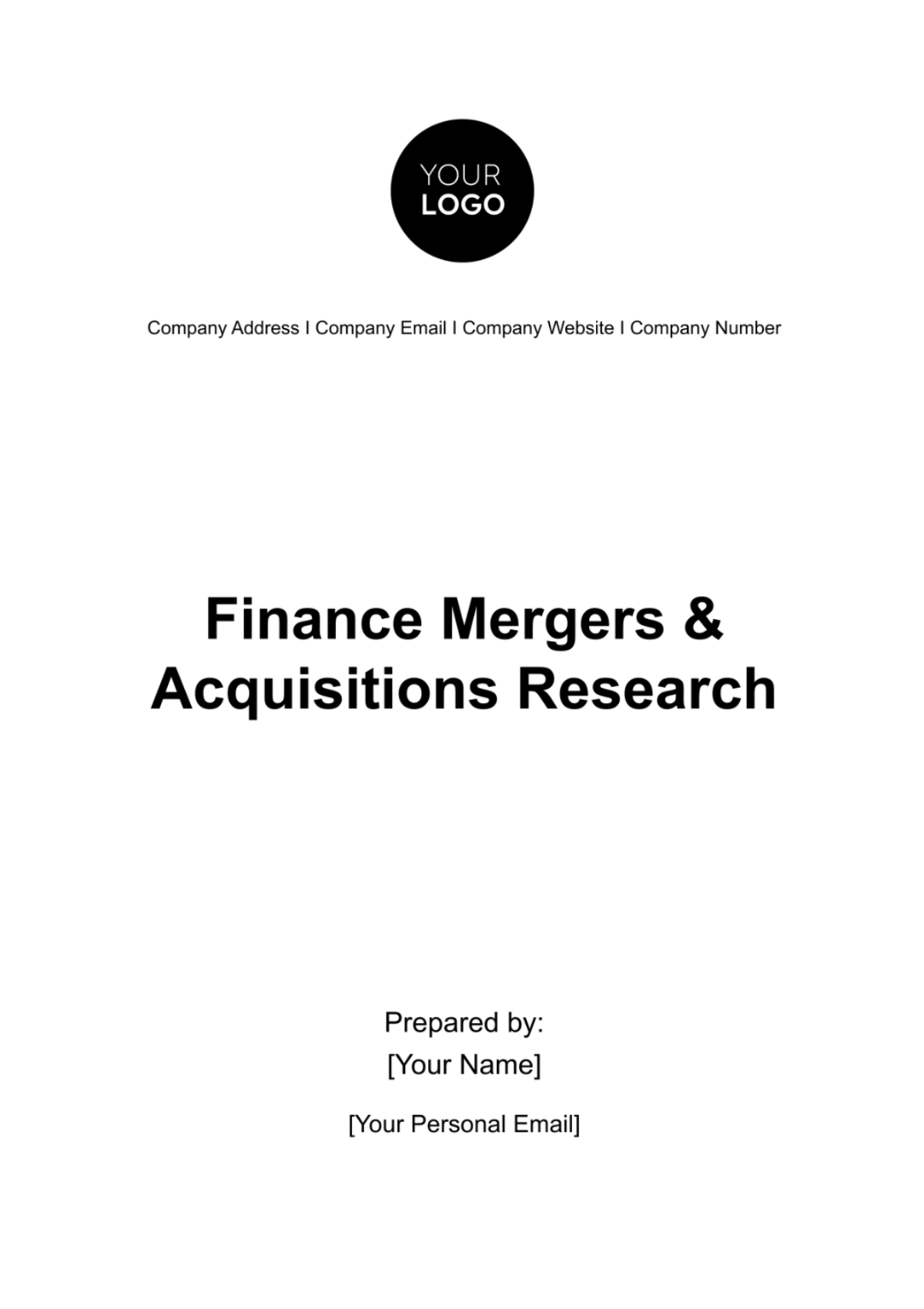
Introduction
In a dynamic and increasingly interconnected global market, strategic mergers and acquisitions (M&A) stand as a cornerstone for fostering growth, innovation, and competitive advantage. This M&A Research is meticulously crafted to serve as a comprehensive guide for our strategic decision-making process. It aims to provide an in-depth understanding of the current M&A landscape, identifying opportunities and challenges that align with our overarching corporate objectives.
Scope
This report encompasses a broad spectrum of elements integral to the M&A landscape. We delve into the current market overview, dissecting trends, and patterns observed in recent transactions. We also critically analyze the regulatory landscape, which plays a crucial role in shaping the feasibility and structure of potential deals. A significant portion of this report is dedicated to the financial and strategic analysis of recent deals, drawing from them lessons and insights pertinent to our future endeavors. Additionally, we explore the impact of these transactions on the companies involved and the broader market, while also projecting future trends and potential opportunities for us in various sectors.
Objectives
Our primary objectives in assembling this report are:
To Gain Market Insight: Understanding the current trends, deal sizes, and sectors active in M&A will inform our approach and strategy.
To Assess Regulatory Impacts: Evaluating the global and regional regulatory environments helps us navigate potential legal and compliance challenges in future M&A activities.
Financial and Strategic Analysis: By examining recent deals, we aim to understand the financial health and strategies of entities involved in significant M&A activities, which will guide our valuation and negotiation tactics.
Risk and Impact Assessment: Identifying risks and assessing the impact of M&A activities will aid in mitigating potential challenges and maximizing the value of any transaction we undertake.
Future Planning: Utilizing our findings to forecast future M&A trends, we aim to position ourselves advantageously in upcoming opportunities, ensuring sustained growth and market relevance.
Market Overview
This section presents a comprehensive overview of the current trends in mergers and acquisitions, offering insights into the evolving dynamics of the M&A landscape. We focus on the sectors experiencing significant consolidation, the average size of deals within these sectors, and the geographical distribution of these activities, with a particular emphasis on the United States market.
Sector | Average Deal Size (USD) | Geographical Distribution in the US |
Technology | 500 Million | Predominantly in Silicon Valley, Seattle, and Austin |
Healthcare | 350 Million | Widespread, with concentrations in Boston, Raleigh-Durham, and San Francisco |
Financial Services | 450 Million | Primarily in New York City, Chicago, and Charlotte |
Retail | 200 Million | Major urban areas, notably New York City, Los Angeles, and Chicago |
Energy | 600 Million | Concentrated in Texas, Oklahoma, and Pennsylvania |
Manufacturing | 400 Million | Diverse, with hubs in the Midwest and Southeast regions |
Consumer Goods | 300 Million | Scattered, with a focus on the East Coast and Midwest |
Telecom | 550 Million | Strong presence in New York City, Atlanta, and Dallas |
These figures and distributions indicate a dynamic M&A landscape, with particular sectors and regions demonstrating significant activity and growth potential. The technology and energy sectors show the highest average deal sizes, reflecting the high capital intensity and strategic importance of these industries. Geographically, the distribution is skewed towards areas with established industry hubs, indicating both the concentration of expertise and the strategic importance of location in these sectors.
Regulatory Landscape
In this section, we navigate the complex and ever-changing regulatory landscape that significantly influences mergers and acquisitions both globally and within the United States. Understanding these regulatory frameworks is crucial for us to ensure compliance, strategic alignment, and successful execution of any M&A activity.
Global Regulatory Environment
Region/Country | Key Regulatory Aspect | Implication for Our Company |
European Union | Strict antitrust laws, GDPR compliance for data handling | Need for rigorous due diligence on compliance, potential adjustments in data management strategies |
China | Foreign investment restrictions, emphasis on national security | Consideration of joint ventures, potential challenges in technology and telecommunication sectors |
United Kingdom | Post-Brexit trade and competition laws | Necessity to reassess market entry strategies and compliance post-Brexit |
Canada | Review of foreign investments for national security concerns | Possible extended review periods, need for transparent investment and partnership strategies |
Japan | Stringent regulations on foreign ownership in certain sectors | Exploration of strategic alliances, careful sector-specific market entry planning |
National (US) Regulatory Environment
Regulatory Aspect | Implication for Our Company |
Antitrust laws (Sherman Act, Clayton Act) | Vigilant compliance to avoid monopolistic practices, ensuring fair competition |
Committee on Foreign Investment in the United States (CFIUS) reviews | Detailed review of foreign investments, especially in sensitive sectors |
Securities and Exchange Commission (SEC) regulations on M&A disclosures | Rigorous adherence to disclosure requirements, maintaining transparency in transactions |
Tax laws impacting M&A transactions (e.g., corporate tax rates) | Strategic planning to optimize tax implications of M&A deals |
State-specific regulations (e.g., California's privacy laws) | Tailored approaches for compliance with state-level legal requirements |
Recent Deals Analysis
This section provides a thorough examination of significant recent M&A transactions, offering valuable insights into current market dynamics and strategic trends. By analyzing the size, involved companies, industry sectors, and the underlying rationale of these transactions, we can draw critical lessons to inform our M&A strategy.
Deal | Size of Deal (USD) | Companies Involved | Industry Sector | Rationale Behind Merger/Acquisition |
Deal A | 2 Billion | Company X & Company Y | Technology | Company X aimed to expand its digital services portfolio and leverage Company Y's innovative AI technologies |
Deal B | 1.5 Billion | Company Z & Company W | Healthcare | Company Z's acquisition of Company W was driven by the need to diversify into biotechnology and pharmaceuticals |
Deal C | 800 Million | Company M & Company N | Financial Services | Company M sought to enhance its FinTech capabilities and customer base by acquiring Company N |
Deal D | 1.2 Billion | Company O & Company P | Retail | The merger was strategized to combine Company O's extensive distribution network with Company P's e-commerce strength |
Deal E | 700 Million | Company Q & Company R | Energy | Company Q acquired Company R to expand its renewable energy portfolio and meet growing environmental sustainability demands |
Deal F | 900 Million | Company S & Company T | Manufacturing | This acquisition aimed at consolidating manufacturing capabilities and expanding into new international markets |
Deal G | 1.8 Billion | Company U & Company V | Consumer Goods | The merger was part of a strategic move to leverage synergies in supply chain optimization and broaden the product line |
Deal H | 650 Million | Company W & Company X | Telecom | Company W's acquisition was targeted at enhancing network infrastructure and accelerating 5G rollout |
These transactions highlight a diverse range of strategic objectives, from technological advancement and market expansion to achieving synergies and responding to emerging market trends. In particular, the high-value deals in the technology and healthcare sectors reflect the growing importance of digital innovation and the pharmaceutical industry's expansion, respectively.
Financial Analysis
In this section, we conduct a detailed financial analysis of the entities involved in significant recent M&A activities, as identified in the previous section. This analysis is critical for understanding the financial positioning, valuation metrics, and overall financial health and performance of these entities.
Entity | Valuation Metrics (USD) | Financial Health and Performance |
Company X | P/E Ratio: 25, | Strong growth in revenue and profits, high R&D investment, robust market position in AI technologies |
Company Z | P/E Ratio: 18, | Consistent profitability, expanding market share in healthcare, strategic investments in biotech |
Company M | P/E Ratio: 22, | Solid financial performance, growing customer base in FinTech, effective cost management strategies |
Company O | P/E Ratio: 15, | Diversified revenue streams, strong retail network, challenges in e-commerce integration |
Company Q | P/E Ratio: 20, | Steady revenue growth, investment in renewable energy projects, good liquidity position |
The entities analyzed show a range of financial strengths and challenges. Company X demonstrates strong growth and a robust market position, particularly in AI technology, which is reflected in its high price-to-earnings (P/E) ratio and significant market capitalization. Company Z, operating in the healthcare sector, shows consistent profitability and a strategic focus on biotechnology, indicative of its expanding market influence.
Company M, in the financial services sector, exhibits a solid financial base with a focus on FinTech innovation and customer expansion. Company O, while strong in retail, faces challenges in integrating e-commerce, highlighting an area of potential strategic focus. Lastly, Company Q’s investment in renewable energy and steady revenue growth reflect a strong financial position in the energy sector, balanced with a good liquidity position.
Deal Structuring and Strategy
This section delves into the specifics of how the recent deals, as outlined in the 'Recent Deals Analysis' section, were structured. We examine the methods of payment employed and the strategic rationale behind the structure of each deal, providing critical insights into contemporary M&A strategies.
Deal | Method of Payment | Rationale Behind Structure Chosen |
Deal A | Cash and Stock | Balanced approach to leverage financial stability and align interests of both companies |
Deal B | All Cash | Company Z's preference for immediate control and seamless integration of Company W |
Deal C | Stock Swap | Mutual interest in long-term collaboration and shared growth prospects |
Deal D | Cash, with Earn-Out Provisions | Motivated by performance-based incentives to ensure continued success post-merger |
Deal E | Combination of Cash, Debt Financing | Leveraged debt to finance the deal, reducing immediate capital expenditure for Company Q |
Deal F | Stock | Aimed at preserving liquidity and promoting equity participation for all stakeholders |
Each of these deal structures reveals a unique strategic approach tailored to the specific objectives and circumstances of the involved entities. For instance, the use of cash and stock in Deal A suggests a balanced strategy to ensure financial stability while aligning the interests of both companies. In contrast, the all-cash transaction in Deal B indicates a desire for immediate control and integration. Understanding these diverse structuring strategies is crucial for us in formulating our approach to future M&A activities, ensuring alignment with our strategic goals and financial considerations.
Impact Analysis
This section critically evaluates the impact of M&A activities on the market, with a focus on the consequences for market share, achieved synergies, cost savings, and the overall effect on competition. Through this analysis, we can better understand the broader implications of these transactions for both the entities involved and the market as a whole.
Deal | Market Share Changes | Synergies Achieved | Cost Savings | Impact on Competition |
Deal A | Increased market share in AI tech sector | Enhanced product development and innovation capabilities | $100 Million in R&D | Intensified competition in technology sector |
Deal B | Strengthened position in biotech and pharmaceuticals | Expanded R&D capabilities, broader product portfolio | $150 Million in operational efficiencies | Reduced competition, increased bargaining power |
Deal C | Gained significant share in FinTech market | Integrated customer base and financial technologies | $80 Million in technology development | Heightened competition with traditional financial institutions |
Deal D | Consolidated market presence in retail | Unified online and offline retail strategies | $120 Million in logistics and supply chain | Challenged smaller retail players, intensified e-commerce competition |
Deal E | Boosted share in renewable energy market | Diversification into new energy sectors | $95 Million in operational costs | Encouraged competitive response in energy sector |
Deal F | Expanded manufacturing footprint | Enhanced production capabilities and efficiency | $70 Million in production and materials | Increased pressure on smaller manufacturers |
Deal G | Solidified market dominance in consumer goods | Streamlined supply chain and distribution networks | $110 Million in procurement and distribution | Reduced number of competitors, potentially raising regulatory concerns |
Deal H | Elevated position in telecommunications | Improved network infrastructure and service offerings | $65 Million in network maintenance and upgrades | Altered competitive dynamics, potentially leading to market consolidation |
These insights reveal that while M&A activities often lead to increased market share and operational efficiencies, they also have significant repercussions for competition within various sectors. For instance, while Deals A and C have intensified competition in their respective sectors, Deal G's consolidation has potentially reduced the number of competitors, which could raise regulatory concerns. Understanding these impacts is crucial for us to anticipate and strategize our responses to similar M&A activities in the future, ensuring sustainable growth and competitive advantage.
Future Outlook
In this section, we look ahead, forecasting the sectors likely to experience consolidation, potential regulatory changes, and economic factors that may influence future M&A activities. This forward-looking perspective is crucial for anticipating trends and preparing our strategy to capitalize on emerging opportunities.
Sectors Ripe for Consolidation
Technology: Especially in areas like artificial intelligence, cybersecurity, and cloud computing.
Healthcare: Focused on telemedicine, biotechnology, and personalized medicine sectors.
Renewable Energy: Driven by the global shift towards sustainable energy sources.
Financial Services: Particularly in FinTech and digital banking platforms.
Retail: E-commerce and omnichannel retail are prime areas for consolidation.
Telecommunications: With the expansion of 5G and IoT technologies.
Potential Regulatory Changes
Stricter Antitrust Scrutiny
Data Privacy and Security Regulations
Foreign Investment Restrictions
Environmental Regulations
Economic Factors Influencing M&A Activities
Fluctuations can impact the cost of financing deals.
Economic downturns or booms can significantly affect M&A appetite.
Driving M&A as companies seek to acquire new capabilities.
Influencing M&A in sectors like retail, entertainment, and services.
Case Study
In this section, we delve into a detailed case study of one of the recent M&A deals listed earlier, providing a comprehensive analysis of its intricacies and outcomes. This case study offers a closer look at the strategic motivations, challenges, and successes of the deal, serving as a learning tool for our future M&A endeavors.
Deal A - Company X's Acquisition of Company Y in the Tech Sector
Background: Company X, a leading player in the technology industry, aimed to expand its portfolio in digital services and AI technologies. Company Y, known for its cutting-edge AI innovations, presented a strategic opportunity for Company X to enhance its technological capabilities and market reach.
Deal Structure: The deal was valued at $2 billion, structured as a combination of cash and stock. This structure aimed to leverage financial stability and align the interests of both companies' stakeholders.
Strategic Rationale:
For Company X: To acquire advanced AI technologies and expand its product offerings.
For Company Y: Access to Company X's resources, broader market reach, and financial strength.
Challenges Faced:
Merging the distinct corporate cultures of two technology companies.
Seamlessly integrating Company Y's AI technologies into Company X's existing suite.
Navigating antitrust concerns due to the significant market share gained post-acquisition.
Outcomes:
Company X successfully expanded its presence in the AI sector.
The acquisition led to enhanced R&D capabilities and faster innovation cycles.
Post-acquisition, Company X saw a significant increase in revenue, partly attributed to the new AI-driven products.
Lessons Learned:
The need for proactive strategies in managing cultural integration.
The value of aligning acquisition goals with overall corporate strategy.
The necessity of anticipating and addressing regulatory challenges in high-stake deals.
Risk Analysis
This section presents a comprehensive risk analysis associated with M&A activities, identifying potential risks, their likelihood, impact, and strategies for mitigation. Understanding these risks is essential for us to proactively manage and navigate the complexities inherent in mergers and acquisitions.
Risk | Likelihood | Impact | Mitigation Strategy |
Regulatory Approval Challenges | High | Severe | Engage in pre-merger consultations, ensure regulatory compliance, and prepare contingency plans |
Cultural and Operational Integration | Medium | High | Develop a detailed integration plan, focus on communication and change management |
Overvaluation of Target Company | Medium | Moderate | Conduct thorough due diligence, utilize external financial advisors, and establish realistic valuation models |
Market Competition and Antitrust Issues | High | Severe | Perform competitive analysis, engage with antitrust consultants, and prepare for possible divestitures |
Post-Merger Performance Not Meeting Expectations | High | Moderate | Set realistic performance targets, continuous monitoring and adjustment post-merger |
Financing Risks | Low | High | Secure diverse financing options, maintain strong balance sheet, and ensure flexibility in financial planning |
Employee Retention and Morale | Medium | Moderate | Communicate effectively with all stakeholders, ensure fair treatment and opportunities during transition |
Conclusion and Recommendations
As we conclude this comprehensive Mergers and Acquisitions Research, it is evident that the landscape of M&A is complex and dynamic, requiring careful consideration and strategic planning. Our analysis has provided critical insights into market trends, regulatory environments, financial assessments, deal structuring, impact analyses, and risk management. These insights are instrumental in guiding our approach to future M&A activities.
Recommendations:
Strategic Alignment: Ensure that any M&A activity aligns with our overarching corporate strategy, particularly focusing on sectors identified as ripe for consolidation.
Rigorous Due Diligence: Prioritize thorough due diligence in all aspects - financial, operational, cultural, and regulatory - to mitigate risks and ensure informed decision-making.
Regulatory Compliance and Anticipation: Stay abreast of evolving regulatory landscapes both globally and in the US, preparing for potential changes that could impact M&A strategies.
Integration Planning: Develop comprehensive integration plans addressing operational, cultural, and technological aspects to ensure smooth transitions post-M&A.
Risk Management: Implement a proactive approach to risk management, identifying potential risks early and devising effective mitigation strategies.
Financial Prudence: Exercise financial prudence in valuations, deal structuring, and financing, balancing ambition with fiscal responsibility.
Stakeholder Communication: Maintain clear and consistent communication with all stakeholders throughout the M&A process to manage expectations and foster trust.
Continuous Monitoring and Adaptation: Post-merger, continuously monitor performance against set targets and remain flexible to adapt strategies as necessary.
Leveraging Technology and Innovation: Embrace opportunities in technology and innovation-driven sectors, ensuring we stay at the forefront of market developments.
Building Relationships and Networks: Cultivate strong relationships with potential M&A targets, industry experts, and regulatory bodies to enhance opportunities and support successful transactions.
- 100% Customizable, free editor
- Access 1 Million+ Templates, photo’s & graphics
- Download or share as a template
- Click and replace photos, graphics, text, backgrounds
- Resize, crop, AI write & more
- Access advanced editor
Discover the Finance Mergers & Acquisitions Research Template from Template.net, expertly designed for financial professionals. Fully editable and customizable in our AI Editor tool, this template streamlines your research process in M&A, providing a comprehensive structure for data analysis and decision-making. Tailor it effortlessly to your specific needs, enhancing efficiency and precision in your financial evaluations.


